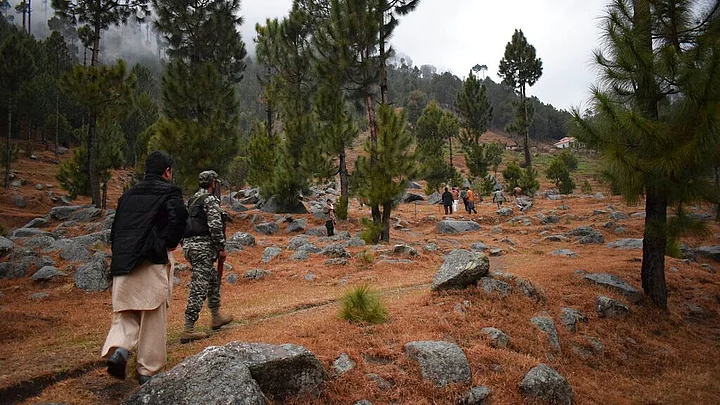Hours after the Indian Air Force (IAF) carried out air strikes across the LoC on 26 February, Foreign Secretary Vijay Gokhale had said that India had struck the “biggest training camp of JeM in Balakot”, adding that “a very large number of JeM terrorists, trainers, senior commanders and groups of jihadis who were being trained for fidayeen action were eliminated.”
A government official even reportedly put the number of militants killed in the strike at 300. Later however, Air Vice Marshal RGK Kapoor said it was “premature” to talk about the number of casualties in the camp, while adding that they were able to achieve their objective. Pakistan, meanwhile, has wholly denied India’s narrative on the damage inflicted due to the strikes.
Ever since the operation took place, several conflicting reports trying to answer what exactly happened in the Balakot area on that day have appeared in the media. While some say there was a considerable number of casualties in the attack, others point out that the strike left only a few civilians injured. The role of a madrassa in the area has also come into focus. Here’s a summary of what a few of these reports say:
Dozens, Including Ex-ISI Officer, Killed in Air Strikes
A report that appeared on Firstpost on 2 March cited eyewitness sources as saying that there were as many as 35 bodies that were transported out from the site in the aftermath of the air strike. Among those who were purportedly killed in the bombing were several former Pakistan military personnel, an ex-ISI officer, and as many as 12 JeM fidayeen trainees.
The report also cites IAF officials who point out how imagery from synthetic aperture radar reveals that four buildings that were targets were indeed destroyed in the strike.
“There’s no doubt that bombs hit their targets. Though some of the numbers that have been appearing in the media are hyperbolic, I think the raid served its purpose, which was to make a point about our ability to strike at terrorist safe havens, rather than extract revenge,” an intelligence official was quoted as saying in the report.
JeM Chief Masood Azhar’s Brother ‘Confirms’ Balakot Camp Strike
An audio message allegedly issued by a senior leader of Jaish-e-Mohammed Maulana Ammar, confirms that Indian jets hit the terror camp in Balakot and caused significant damage, reported Hindustan Times. Ammar is reportedly the brother of JeM founder Masood Azhar.
This is contradictory to Islamabad’s claims that India hit only a patch of trees.
“Let me remind you that the Indian aircrafts did not bomb the safe house of any agency, they didn’t attack any headquarters, they didn’t attack the meeting points of agencies (JeM), they attacked the schools where students were being trained to understand jihad better and vowed to help ‘oppressed’ Kashmiris. By entering our territories and attacking our schools, India has ensured the beginning of jihad against them,” the message reportedly said.
Only One Civilian Victim of Balakot Air Strike?
A ground report by Reuters that came out on 28 February cited several locals and health officials from the Balakot area as saying that there were no casualties owing to the air strike, except for one civilian who was injured.
“No one died. Only some pine trees died, they were cut down. A crow also died,” a local named Abdur Rasheed told the news agency.
Moreover, the locals pointed out that there was no training camp in the area, but a madrassa that was affiliated with the Jaish-e-Mohammed. The absence of a militant camp in the area was further corroborated by western diplomats quoted in the report, who said that the facility was moved and hasn’t been at the site “for a few years”.
Though reporters were denied access into it, the madrassa structure did not appear to be damaged, the report said.
Function of the Madrassa: A Training Camp, Recruitment Centre?
The ground report by Al Jazeera that was also published on 28 February echoes what the Reuters report indicates, in that the IAF air strikes in the Balakot area did not lead to any casualties or serious damage to buildings.
Having talked to locals and local officials, the report said that the air raids “destroyed parts of a mostly uninhabited forest and a farmer’s field”, leaving behind blast craters and splintered pine trees.
However, where it differs with Reuters is over what it labels as the “mysterious JeM religious school” – the Madrassa Taleem-ul-Quran.
A signboard close to the madrassa named Masood Azhar as its leader and Muhammad Yousuf Azhar as its administrator, the report says.
Notably, after the air strikes, India had said that the JeM facility was headed by Masood Azhar’s brother-in-law Maulana Yusuf Azhar.
As far as the functions of the madrassa are concerned, while some locals told Al Jazeera it was used only for religious education, others said that it was an active “Jaish camp” and a “training camp for religious fighters”.
The report cites an article of a JeM-affiliated publication to point out that the madrassa was used as an active recruitment centre.
It further refers to a 2004 US Department of Defense memo, reportedly leaked by Wikileaks, which pointed out that a camp provided “basic and advanced terrorist training” in the area.
